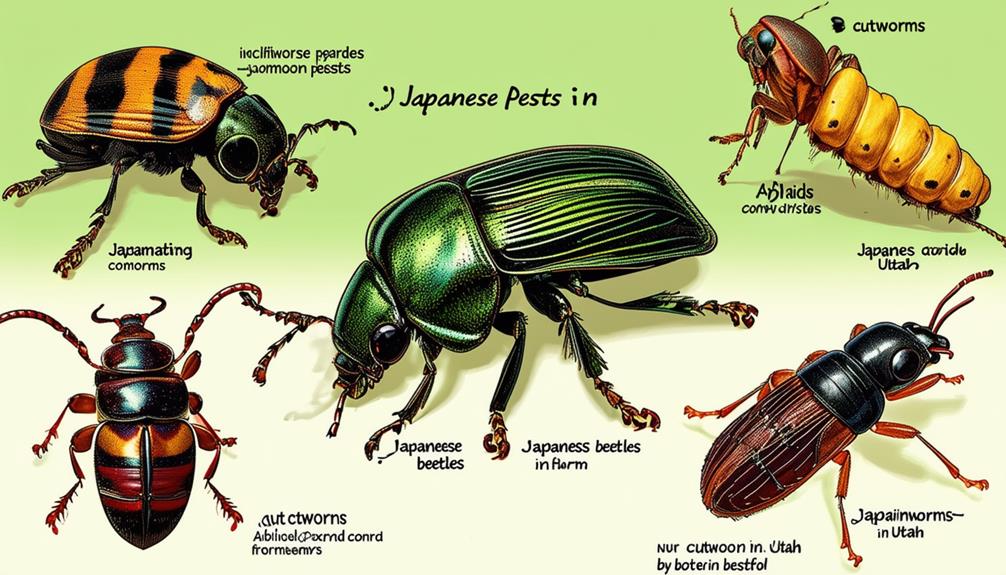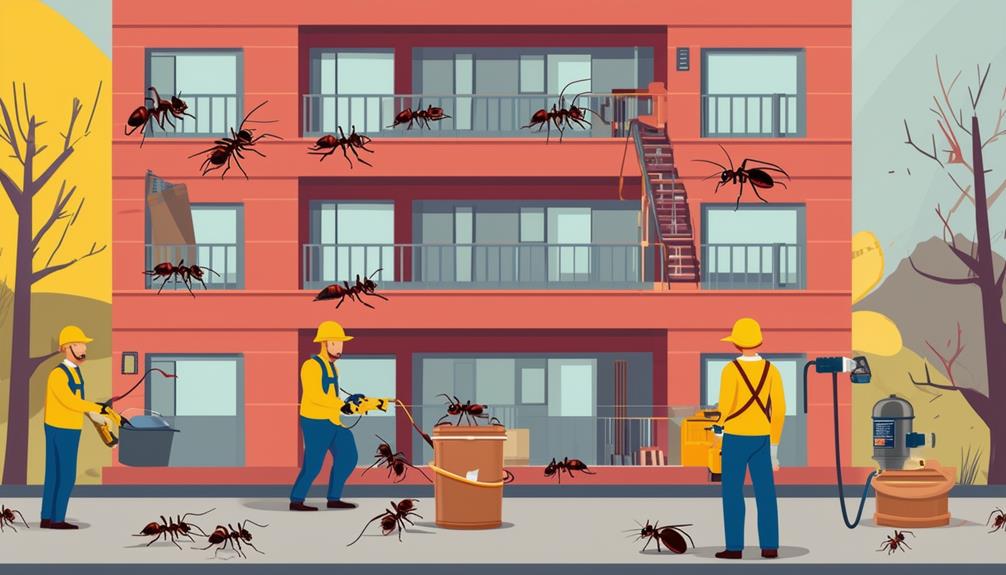When tending to your garden in Utah, you may encounter various pests that can jeopardize the health of your plants. From the elusive Japanese beetle to the destructive squash vine borer, these pests can quickly become a nuisance in your yard. Understanding how to identify and effectively control these common garden pests is essential for safeguarding your plants and ensuring a bountiful harvest. By learning more about these pesky intruders and implementing targeted strategies, you can protect your garden and promote a thriving ecosystem.
Key Takeaways
- Look for signs of wilting grass to identify grub infestations.
- Maintain proper lawn care practices to deter chinch bugs in hot areas.
- Use granular insecticides for controlling mole crickets in the lawn.
- Implement Integrated Pest Management strategies for army worms and cutworms.
- Repel moles and voles naturally with castor oil and garlic.
Grubs and Lawn Damage
When monitoring your lawn for potential pest infestations, grubs, the creamy white larvae of scarab beetles, present a significant threat due to their destructive feeding habits on grass roots. These voracious feeders are most active during the spring and summer months, causing visible damage such as dry, brown patches in the grass. To detect their presence, look for signs like wilting grass that easily detaches from the soil due to root damage.
To effectively control grubs and minimize lawn damage, you can use a simple trick involving dishwashing detergent. Mix a solution of water and dish soap, then pour it over affected areas. The soap irritates the grubs, causing them to surface, making it easier to remove them manually or through other control methods.
Proper identification and timely intervention are essential in managing grub infestations. Regularly monitoring your lawn for signs of damage and taking preventive measures can help safeguard your grass from the detrimental effects of these root-feeding pests.
Chinch Bugs in Hot Areas
Chinch bugs, commonly found in hot, sunny areas with dry conditions, pose a significant threat to lawns by extracting moisture from grass plants. These tiny insects have piercing mouthparts that they use to suck sap from grass blades, causing the grass to wilt and turn yellow. Chinch bug infestations are often misinterpreted as drought stress because the damage they cause resembles the effects of lack of water.
To deter chinch bugs from damaging your lawn, it's essential to maintain proper lawn care practices. Aeration and dethatching can help improve soil conditions and grass health, making the lawn less attractive to these pests. Additionally, fertilizing the lawn appropriately can promote grass growth and resilience against chinch bug attacks.
If chinch bugs have already infested your yard, granular insecticides specifically designed to target these pests can be an effective control method. Applying these chemicals according to the manufacturer's instructions can help eradicate chinch bugs and prevent further damage to your lawn.
Mole Crickets Withering Grass
Mole crickets, known for their burrowing habits and feeding on insects and plants, contribute to the withering of grass in lawns. When mole crickets infest a lawn, they can cause significant damage by feeding on grassroots, leading to the deterioration of the grass in affected areas. Over-watering lawns can attract mole crickets, increasing the chances of infestations. One way to identify a mole cricket infestation is by observing brown patches on the lawn, indicating areas where the grass is being damaged.
To effectively manage mole crickets in your lawn, consider using granular insecticides for extensive infestations. These insecticides can help control the mole cricket population and prevent further damage to the grass. It is essential to address mole cricket infestations promptly to protect the health and appearance of your lawn.
| Mole Crickets Facts | |
|---|---|
| Burrow through soil | Feeding on insects and plants |
| Over-watering attracts them | Granular insecticides for control |
| Brown patches on lawn | Damage grassroots and cause withering |
Army Worms and Cutworms Feeding
Feeding on grass blades and stems, army worms and cutworms are common pests that can cause significant damage to lawns in Utah. These pests can be detrimental to the health and appearance of your lawn. Army worms and cutworms are known for staying hidden during the day, which can make early detection challenging. To identify their presence, a detergent test method can be employed to spot infestations in the lawn.
Integrated Pest Management (IPM) strategies are vital when dealing with army worms and cutworms. This approach involves a combination of techniques such as monitoring, cultural practices, biological control, and, if necessary, the use of pesticides. For a severe infestation, seeking help from a professional exterminator might be necessary to effectively control the population of these pests.
Keep an eye out for dead spots on your lawn, as they can indicate the presence of army worms and cutworms. Prompt action and a well-rounded IPM plan are essential to protect your lawn from these destructive pests.
Natural Repellents for Moles and Voles
When considering methods to deter moles and voles from damaging lawns, utilizing natural repellents such as castor oil and garlic emerges as an effective and environmentally friendly solution. Mole activity is characterized by the presence of mounds and raised ridges in yards, while voles create destructive paths through grass. Castor oil, derived from the castor bean plant, contains a compound that's unpleasant to these pests, encouraging them to vacate the area. Garlic, known for its strong scent, disrupts the sensitive smell of moles and voles, deterring them from burrowing in lawns. These natural repellents work by creating an environment that these pests find inhospitable.
Additionally, incorporating decaying organic matter into the soil can help repel moles and voles as they dislike the strong odors produced during decomposition. By using these organic products, you can effectively control and prevent mole and vole infestations in your yard while minimizing harm to the environment.
Frequently Asked Questions
How Do I Identify Pests in My Garden?
To identify pests in your garden, observe signs like holes in leaves or slime trails. Look for aphids, earwigs, slugs, snails, pillbugs, and sowbugs. Use resources like the Utah Vegetable Pests Identification Guide for help. Monitor plant health consistently for early detection.
How Can You Identify the Type of Pest You Are Dealing With?
To identify the type of pest you're dealing with, observe physical traits like color, size, and damage patterns on plants. Use online guides for visual references. Consult local agricultural services or use traps for identification.
How to Identify and Control Common Garden Pests by Leaf Signatures?
When examining leaf signatures, you can pinpoint common garden pests. Noticing distinct patterns like skeletonization or stippling helps in identification. Once recognized, appropriate control measures can be taken, aiding in targeted pest management strategies.
What Is the Most Common Garden Pest?
The most common garden pest you face is the tiny but mighty aphid. Pest prevention starts with vigilant monitoring and early action. Remember, a single aphid can give rise to colonies swiftly, posing a threat to your garden's health.




